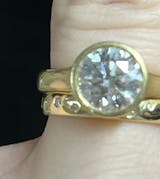I knew what I was looking for when looking for a wedding ring. I searched near and far for a simple curved wedding band with an interesting finish that came in 14k rose gold. I was so excited to find it at Nodeform. After I ordered, I was pleasantly surprised to get a personal message from Konstanze asking about the dimensions of my engagement ring so she could make sure to create a band that fit right. The whole process was smooth and easy, and the ring came with a hand written note to thank me for my order.
I really do love the idea of this ring. Overall it has a beautiful craftsmanship however, it is significantly thinner than my engagement ring so it looks stepped which bothers me and is hard to ignore since I wanted to wear this as my wedding band. The width is the same as my engagement ring, 3 mm, but I didn’t think to ask for a similar thickness. I had tried on quite a few wedding bands in preparation for ordering this and they were all the same thickness as my engagement ring so I foolishly thought it would be standard. I’m trying to love it with my engagement ring but I am disappointed that it is so much thinner. Unfortunately the restocking fee for sending this back and having one made that is the same thickness as my engagement ring is cost prohibitive. Again, I do love the idea of this ring with the scattered diamonds. It is beautifully made.
Textured Engagement Ring with Fair Trade Green Cushion Cut Sapphire & Diamonds Accents
This is a really beautiful ring, with nice sparkle. The recipient is delighted.
I absolutely love the subtle and dynamic form of this pendent. The detail and craft are top notch as I've come to expect from Nodeform. I also got matching earrings and the whole ensemble is super classy and contemporary. The scale of these pieces was somewhat hard to gage from the photos, but in person the size is Goldilocks, not too big, not too small. These are a christmas present for my partner and I cannot wait for them to open them and try them on! I would highly recommend!
















